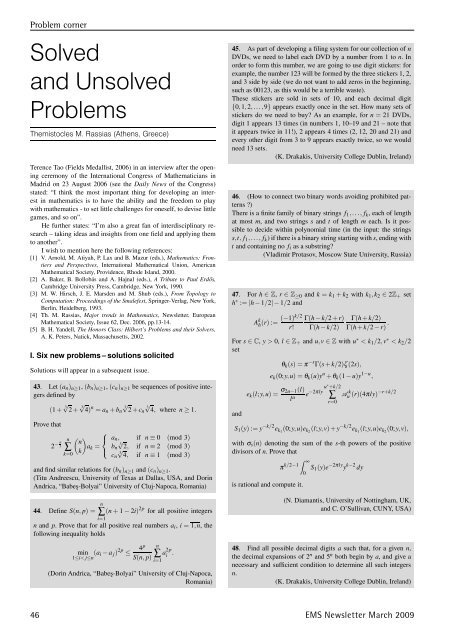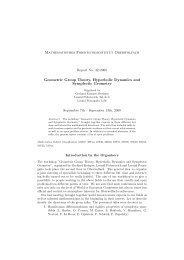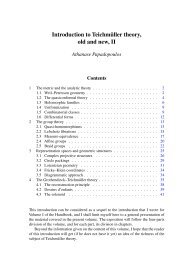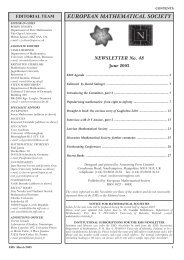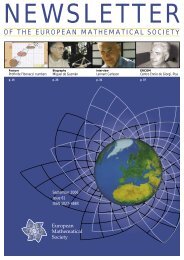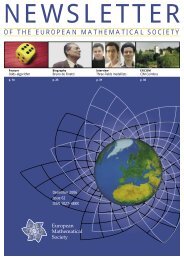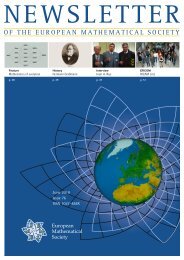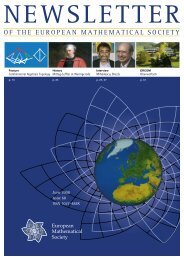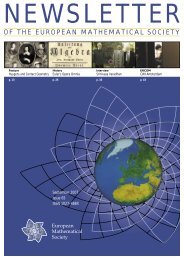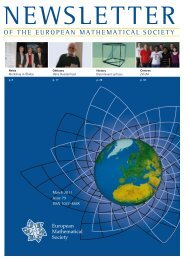New from Springer - European Mathematical Society Publishing ...
New from Springer - European Mathematical Society Publishing ...
New from Springer - European Mathematical Society Publishing ...
Create successful ePaper yourself
Turn your PDF publications into a flip-book with our unique Google optimized e-Paper software.
Problem corner<br />
Solved<br />
and Unsolved<br />
Problems<br />
Themistocles M. Rassias (Athens, Greece)<br />
Terence Tao (Fields Medallist, 2006) in an interview after the opening<br />
ceremony of the International Congress of Mathematicians in<br />
Madrid on 23 August 2006 (see the Daily <strong>New</strong>s of the Congress)<br />
stated: “I think the most important thing for developing an interest<br />
in mathematics is to have the ability and the freedom to play<br />
with mathematics - to set little challenges for oneself, to devise little<br />
games, and so on”.<br />
He further states: “I’m also a great fan of interdisciplinary research<br />
– taking ideas and insights <strong>from</strong> one field and applying them<br />
to another”.<br />
I wish to mention here the following references:<br />
[1] V. Arnold, M. Atiyah, P. Lax and B. Mazur (eds.), Mathematics: Frontiers<br />
and Perspectives, International <strong>Mathematical</strong> Union, American<br />
<strong>Mathematical</strong> <strong>Society</strong>, Providence, Rhode Island, 2000.<br />
[2] A. Baker, B. Bollobás and A. Hajnal (eds.), A Tribute to Paul Erdős,<br />
Cambridge University Press, Cambridge, <strong>New</strong> York, 1990.<br />
[3] M. W. Hirsch, J. E. Marsden and M. Shub (eds.), From Topology to<br />
Computation: Proceedings of the Smalefest, <strong>Springer</strong>-Verlag, <strong>New</strong> York,<br />
Berlin, Heidelberg, 1993.<br />
[4] Th. M. Rassias, Major trends in Mathematics, <strong>New</strong>sletter, <strong>European</strong><br />
<strong>Mathematical</strong> <strong>Society</strong>, Issue 62, Dec. 2006, pp.13-14.<br />
[5] B. H. Yandell, The Honors Class: Hilbert’s Problems and their Solvers,<br />
A. K. Peters, Natick, Massachusetts, 2002.<br />
I. Six new problems – solutions solicited<br />
Solutions will appear in a subsequent issue.<br />
43. Let(an)n≥1, (bn)n≥1, (cn)n≥1 be sequences of positive integers<br />
defined by<br />
Prove that<br />
(1 + 3√ 2 + 3√ 4) n = an + bn 3√ 2 + cn 3√ 4, where n ≥ 1.<br />
n −<br />
2 3<br />
n<br />
∑<br />
k=0<br />
� �<br />
n<br />
k<br />
⎧<br />
⎨<br />
ak =<br />
⎩<br />
an, if n ≡ 0 (mod 3)<br />
bn 3√ 2, if n ≡ 2 (mod 3)<br />
cn 3√ 4, if n ≡ 1 (mod 3)<br />
and find similar relations for (bn)n≥1 and (cn)n≥1.<br />
(Titu Andreescu, University of Texas at Dallas, USA, and Dorin<br />
Andrica, “Babe¸s-Bolyai” University of Cluj-Napoca, Romania)<br />
n<br />
44. Define S(n, p) = ∑(n<br />
+ 1 − 2i)<br />
i=1<br />
2p for all positive integers<br />
n and p. Prove that for all positive real numbers ai, i = 1,n, the<br />
following inequality holds<br />
min<br />
1≤i< j≤n (ai − a j) 2p ≤ 4p<br />
S(n, p)<br />
n<br />
∑<br />
i=1<br />
a 2p<br />
i .<br />
(Dorin Andrica, “Babe¸s-Bolyai” University of Cluj-Napoca,<br />
Romania)<br />
45. As part of developing a filing system for our collection of n<br />
DVDs, we need to label each DVD by a number <strong>from</strong> 1 to n. In<br />
order to form this number, we are going to use digit stickers: for<br />
example, the number 123 will be formed by the three stickers 1, 2,<br />
and 3 side by side (we do not want to add zeros in the beginning,<br />
such as 00123, as this would be a terrible waste).<br />
These stickers are sold in sets of 10, and each decimal digit<br />
{0,1,2,...,9} appears exactly once in the set. How many sets of<br />
stickers do we need to buy? As an example, for n = 21 DVDs,<br />
digit 1 appears 13 times (in numbers 1, 10–19 and 21 – note that<br />
it appears twice in 11!), 2 appears 4 times (2, 12, 20 and 21) and<br />
every other digit <strong>from</strong> 3 to 9 appears exactly twice, so we would<br />
need 13 sets.<br />
(K. Drakakis, University College Dublin, Ireland)<br />
46. (How to connect two binary words avoiding prohibited patterns<br />
?)<br />
There is a finite family of binary strings f1,..., fk, eachoflength<br />
at most m, and two strings s and t of length m each. Is it possible<br />
to decide within polynomial time (in the input: the strings<br />
s,t, f1,..., fk) if there is a binary string starting with s, ending with<br />
t and containing no fi as a substring?<br />
(Vladimir Protasov, Moscow State University, Russia)<br />
47. For h ∈ Z, r ∈ Z≥0 and k = k1 + k2 with k1,k2 ∈ 2Z+ set<br />
h ∗ := |h − 1/2|−1/2 and<br />
A k (−1)k/2 Γ(h − k/2 + r) Γ(h + k/2)<br />
h (r) :=<br />
r! Γ(h − k/2) Γ(h + k/2 − r) .<br />
For s ∈ C, y > 0, l ∈ Z+ and u,v ∈ Z with u∗ < k1/2,v∗ < k2/2<br />
set<br />
θk(s)=π −s Γ(s + k/2)ζ(2s),<br />
ek(0;y,u)=θk(u)y u + θk(1 − u)y 1−u ,<br />
ek(l;y,u)= σ2u−1(l)<br />
lu e −2πly u∗ +k/2<br />
∑ A<br />
r=0<br />
k<br />
u (r)(4πly)−r+k/2<br />
46 EMS <strong>New</strong>sletter March 2009<br />
and<br />
S1(y) := y −k/2 ek1 (0;y,u)ek2 (l;y,v)+y−k/2ek1 (l;y,u)ek2 (0;y,v),<br />
with σs(n) denoting the sum of the s-th powers of the positive<br />
divisors of n. Prove that<br />
π k/2−1<br />
� ∞<br />
S1(y)e<br />
0<br />
−2πly y k−2 dy<br />
is rational and compute it.<br />
(N. Diamantis, University of Nottingham, UK,<br />
andC.O’Sullivan,CUNY,USA)<br />
48. Find all possible decimal digits a such that, for a given n,<br />
the decimal expansions of 2 n and 5 n both begin by a, andgivea<br />
necessary and sufficient condition to determine all such integers<br />
n.<br />
(K. Drakakis, University College Dublin, Ireland)


